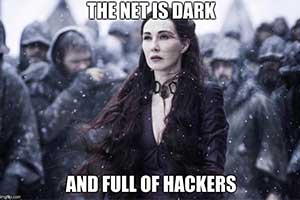THE NET IS DARK AND FULL OF HACKERS

Websites and computers can never be completely free from the risk of malware. Just as we expose ourselves to disease all our lives, so too, website servers and computer systems can be infected by malware at any point. This vulnerability was exploited not a few days ago with HBO’s servers hacked and countless sensitive files stolen – including an episode of the show we all love, ‘Game of Thrones’. It just goes to show that even the biggest corporations are not safe from the terrors of hacking. However, concerted website security measures and regular website maintenance make it possible to prevent most malware attacks from affecting your website.
Nevertheless, there appear from time to time, certain strains of malware that most websites lack protection from. Most recently we witnessed the spread of NotPetya, a malware attack that disguised itself as ransomware to affect more than 2,000 individuals and corporations across the world. Originating in Ukraine, this malware did not extort money as a ransomware should, instead locking files on the system with no means of recovering them. NotPetya used the NSA hacking tool, EternalBlue to breach systems with unpatched security and steal passwords in order to gain administrator access to the entire network. It then began spreading itself as a forced update to all machines on the network, before encrypting their hard drives. The malware spread rapidly across the globe, with systems of companies and individuals in Russia, U.S.A., India, U.K., France, Germany, Denmark and Australia reportedly affected. That the malware wreaked havoc on the monitoring systems at Chernobyl nuclear power plant serves as an indicator of the sheer vulnerability of systems no matter their importance to the organizations or governments involved. Now just a couple of months earlier, the world witnessed a ransomware attack on a much larger scale – the WannaCry attack, which affected systems in almost 150 countries. Major organizations and governments were affected the world over, and all it took was a simple hyperlink to disrupt systems everywhere.
However, there are several measures to keep malware at bay, and your data safe throughout the year. Regular website maintenance, for starters, can go a long way in keeping your website safe from hackers. Since WordPress operates on an open source platform, its code is easily vulnerable to hacking and only regular updates can keep your website secure at any given time. Security plugins such as Bulletproof Security and SiteLock also monitor vulnerabilities on a daily basis. Separating your browser and website with a level of encryption by obtaining an SSL (Secure Sockets Layer) certificate can keep important customer information safe, especially in a business where customers might feel uncomfortable revealing their credit card information online. It is also easy to overlook the basics, such as maintaining strong passwords and changing them on a regular basis. Far from avoiding the usual suspects, it is imperative to use a random combination of letters and numbers to reduce the chances of hacking. Sure, it may be difficult to focus on all this alongside your business, making it prudent to avail website maintenance services and ensure the focus remains on growth and expansion of your business, while your security needs are safely taken care of.
